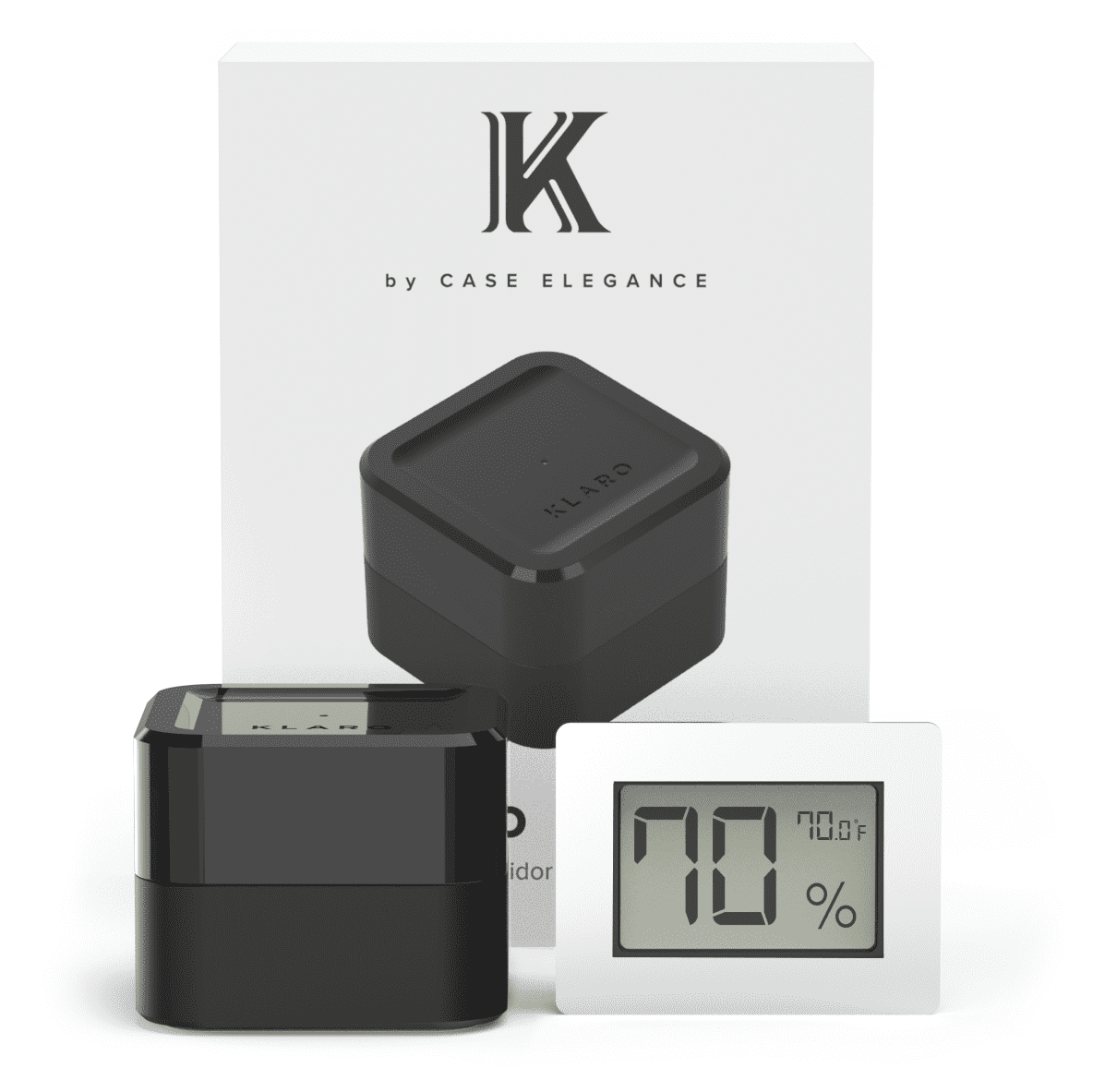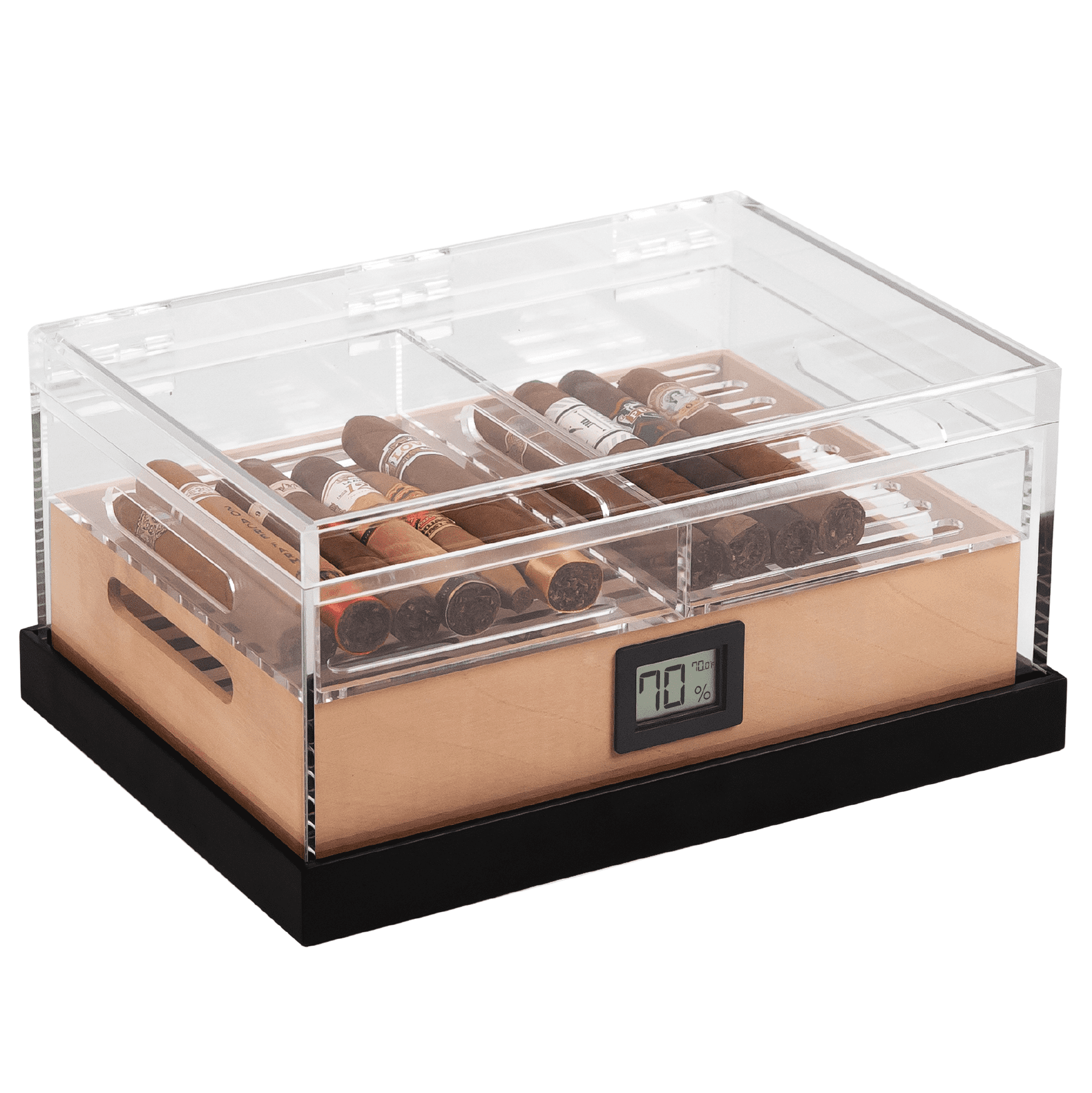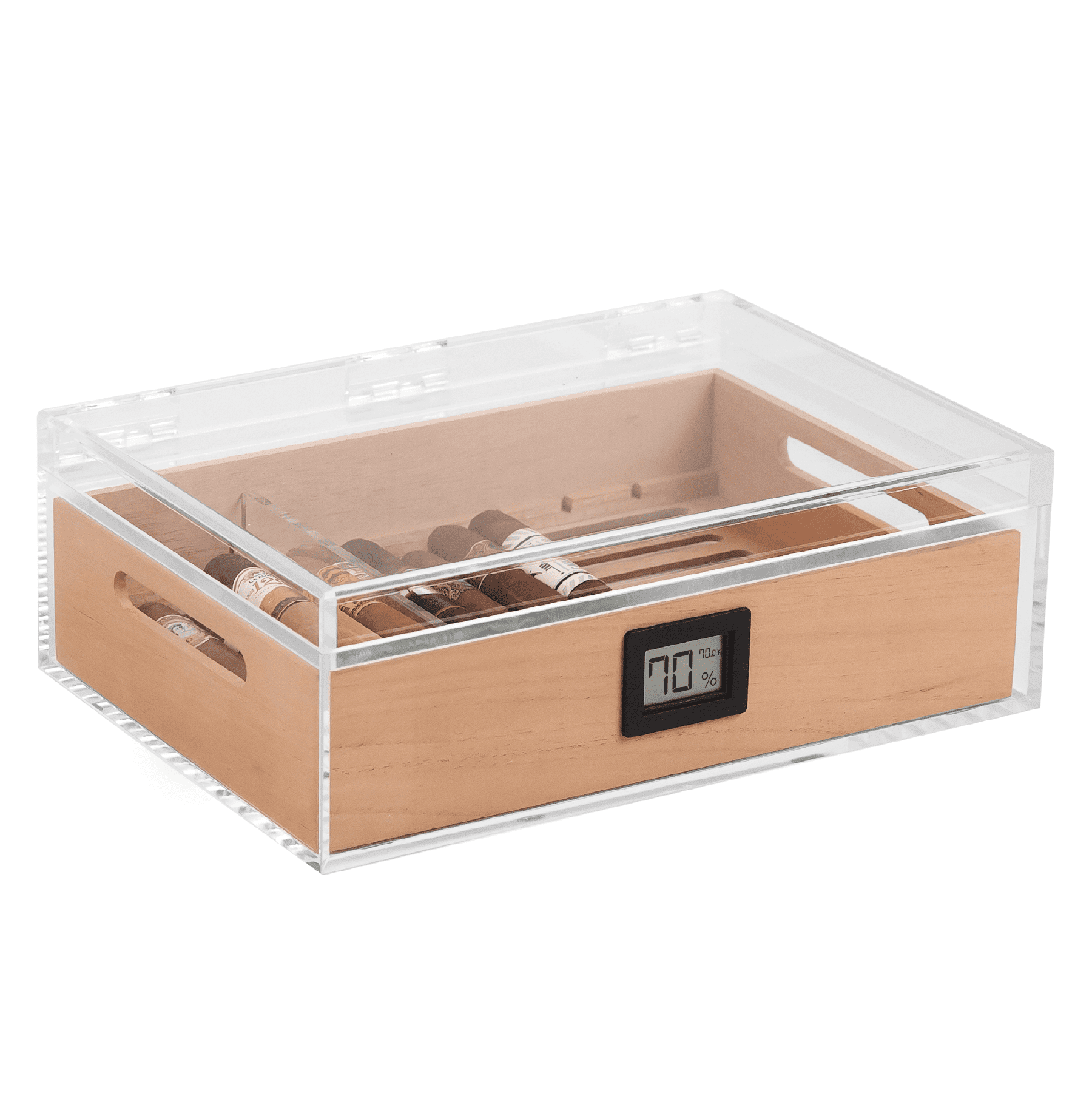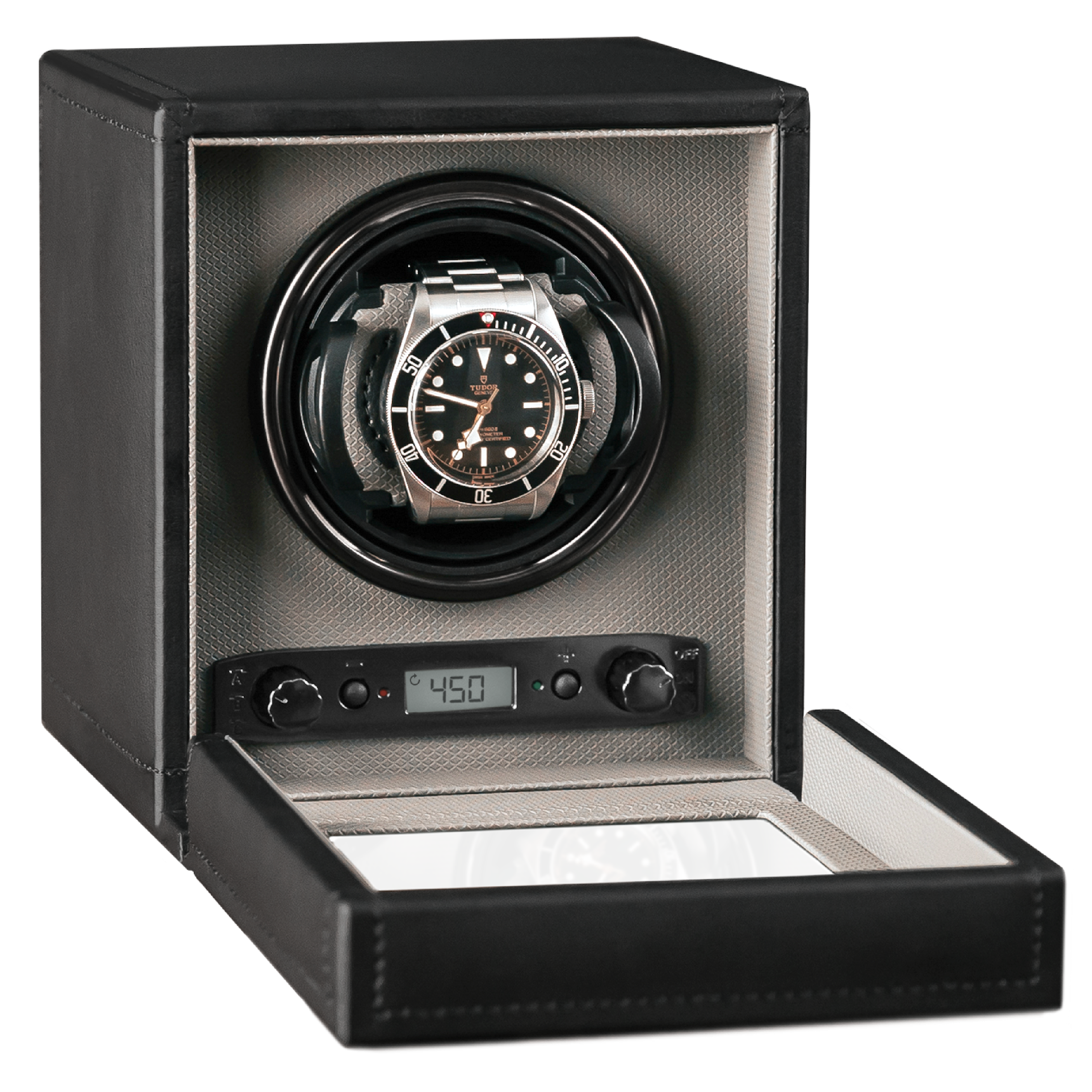- A properly seasoned humidor won't fluctuate with added cigars.
- To properly season your humidor, the wood needs sufficient moisture saturation.
- The seasoning process typically takes a week to fully establish baseline humidity.
- Monitor your humidor's humidity levels with a hygrometer during the seasoning process.
- Your humidor requires a sufficient humidification system to distribute moisture consistently.
The true test of a humidor’s quality is its ability to manage humidity levels. A properly seasoned humidor maintains ideal cigar-storage humidity levels between 65% and 72% relative humidity, regardless if you add cigars or open it frequently. And that’s due to the seasoning process.
Seasoning bolsters the wood inside with enough humidity so that it can respond to climatic changes. But the question is: if my humidor reads 65%-72%, how do I know if it’s actually seasoned sufficiently?
This is a daunting question to many first-time humidor purchasers. You’ve gone out and purchased a new humidor, maybe even your second, and now you're racking your brain, trying to make sure you prep the humidor to do its job: alleviate the worry that your cigars will go bad.
Well, worry no more. If you own a Klaro humidor, check out the seasoning tutorials for each model. But let’s walk through some of the key steps and elements of humidor seasoning so you know what to do, what you’re looking for, and how the humidor functions.
The Proper Seasoning Method
Seasoning is the process of building up a lot of initial humidity within your humidor so that the wood inside is fully stocked with moisture before you add cigars. This process sets up your humidor for long-term performance.
These are the basics.
Get your humidor above 70% as a minimum for at least a week before adding cigars. If you can get to 80%, that’s even better. At this stage, you are focused on boosting the moisture saturation within the wood.
There are multiple ways to achieve +70% humidity depending on the type of humidor you own. But Klaro humidors are designed with a key humidification feature known as the Hydro Tray, which uses a combination of humidor solution, crystal gels, and open-air access to create a reliable humidity source that can respond to fluctuations in humidity levels in your humidor.

Don’t be afraid to add lots of humidor solution and distilled water at this stage. Humidor Solution contains propylene glycol and distilled water. For seasoning, the distilled water will allow you to load more moisture into the humidor wood. Propylene glycol stops evaporating at 70% so if you are stuck there, simply add more distilled water to the humidor, either by adding to the Hydro Tray or inserting a shot glass filled with distilled water. Make sure to keep the temperature as close to 70 degrees Fahrenheit as possible.
Patience Is Key
Be patient — it's not worth rushing the seasoning process. In fact, time is a key factor here: the wood inside your humidor needs this time to build up its moisture content, and the only way for you to know if the seasoning process is working is to see consistent humidity levels over time. There is no way to rush this process without compromising your humidor or receiving subpar results.
It’s tempting to get your cigars into their new home — but you don’t want to rush seasoning, and adding cigars too soon can cause damage to the cigars themselves.
Adding cigars too early, or not giving the distilled water/humidor solution enough time, can also lead to a long-term struggle to maintain humidity within your humidor. And that could mean needing to repeat the process, constantly adding humidor solution, and all the while putting your cigars at risk.
Geography Matters
During the seasoning process, your humidor is establishing its baseline. And if it’s doing so in an especially dry or arid location, the process will be more difficult because it’s trying to establish humid conditions in an area starved of moisture.
Take into account what time of year it is and where you live. If you live in a drier climate or if it’s winter, we recommend seasoning for a full 14 days and supplementing moisture with an extra shot glass of humidor solution or distilled water. During the summer or in a more humid environment, 3-5 days is sufficient.
In this case, an external hygrometer is a helpful tool, because you’ll have a better idea of what your humidor is up against as it tries to establish its own high humidity levels.
How Does A Properly Seasoned Humidor Act?

If you have followed all the seasoning steps outlined for your particular Klaro humidor, your humidor should consistently hold humidity between 65% and 72% relative humidity. Confirm this happens consistently for an extended period of time (a week or more).
Adding cigars may drop the humidity slightly, depending on how dry the cigars are, but a properly seasoned humidor should gradually climb back up to 65% to 72% within 7-10 days. When your humidor is behaving this way, it’s doing its job.
The same is true for frequent openings: the humidity level might drop initially, but it should begin to bounce back soon.
Signs Your Humidor Is Not Properly Seasoned?
So you’ve done the diligence of completing all the steps in the seasoning process. Now what? Once you’ve got a week or more under your belt of consistent humidification levels, it’s time for some harmless product testing.
Try opening the lid until you see the humidity level dip, then close the lid and watch for its response. Your humidor should have no trouble returning to those ideal humidity levels without too much delay. If it struggles to return, you might need to add humidor solution or distilled water. A humidor’s function is to return humidity levels to homeostasis. If it’s not doing this when you open the lid briefly, it’s not seasoned.
If the open/close test has worked, go ahead and add a couple of cigars and observe the changes. Expect a dip. But expect the humidor to begin bouncing back soon after.
If you happen to have a couple of older, cheap, dry cigars hanging around, experiment by adding a few to the humidor and observing the changes. The humidity level might dip more significantly, but after six-to-twelve hours, the humidor should have returned to humidity levels between 65%-72% humidity.
Still Having Problems?
Seasoning is different from humidor to humidor. And it’s not always a cut-and-dry process. You may need to refill the humidor solution and distilled water far more than you thought. If it’s not a Klaro humidor, the wood may not be Spanish cedar, which might not absorb the moisture. Or it could have a seal problem.
If you’re still having problems, check out the multitude of options Case Elegance has available on our help page.














